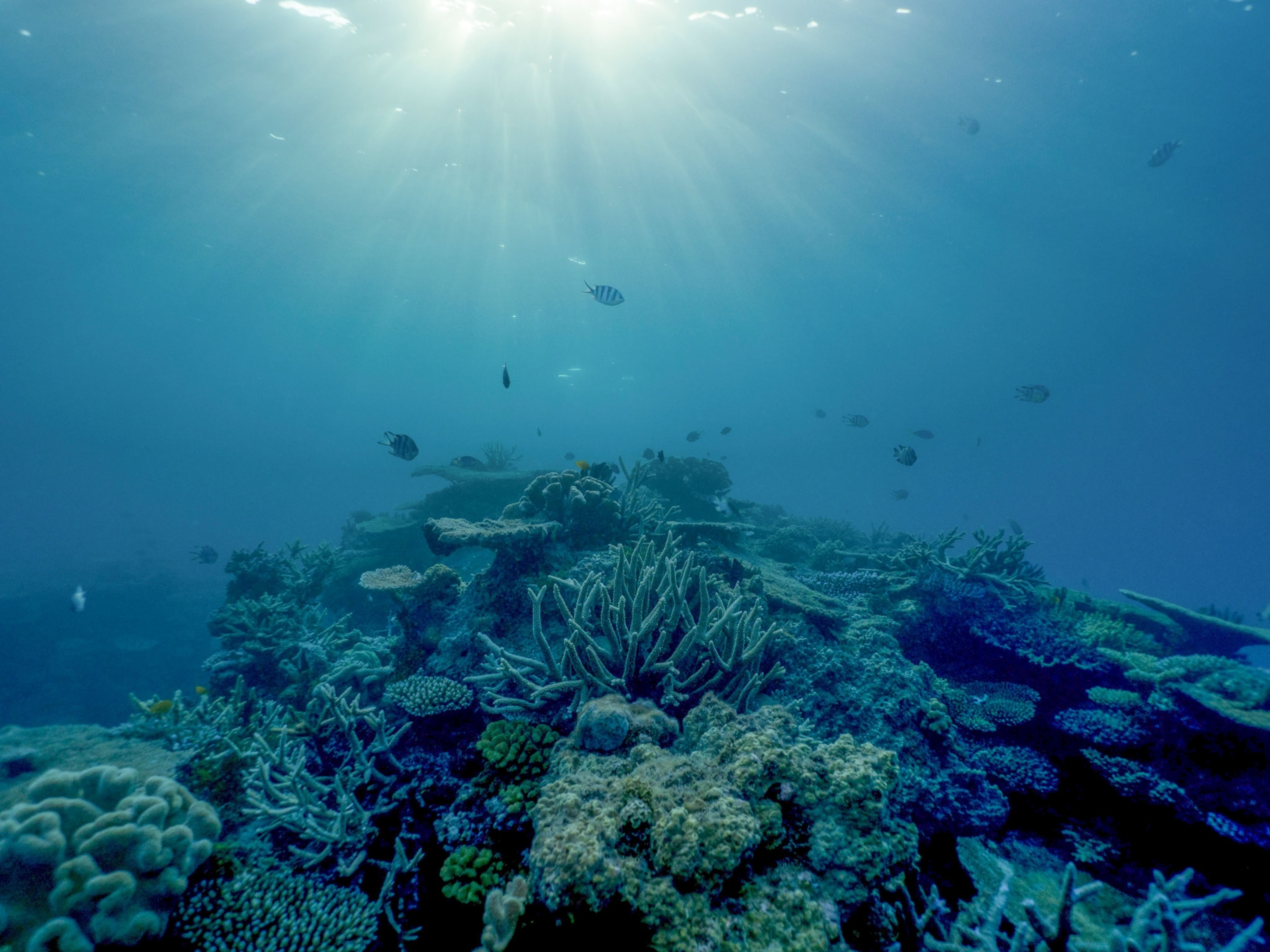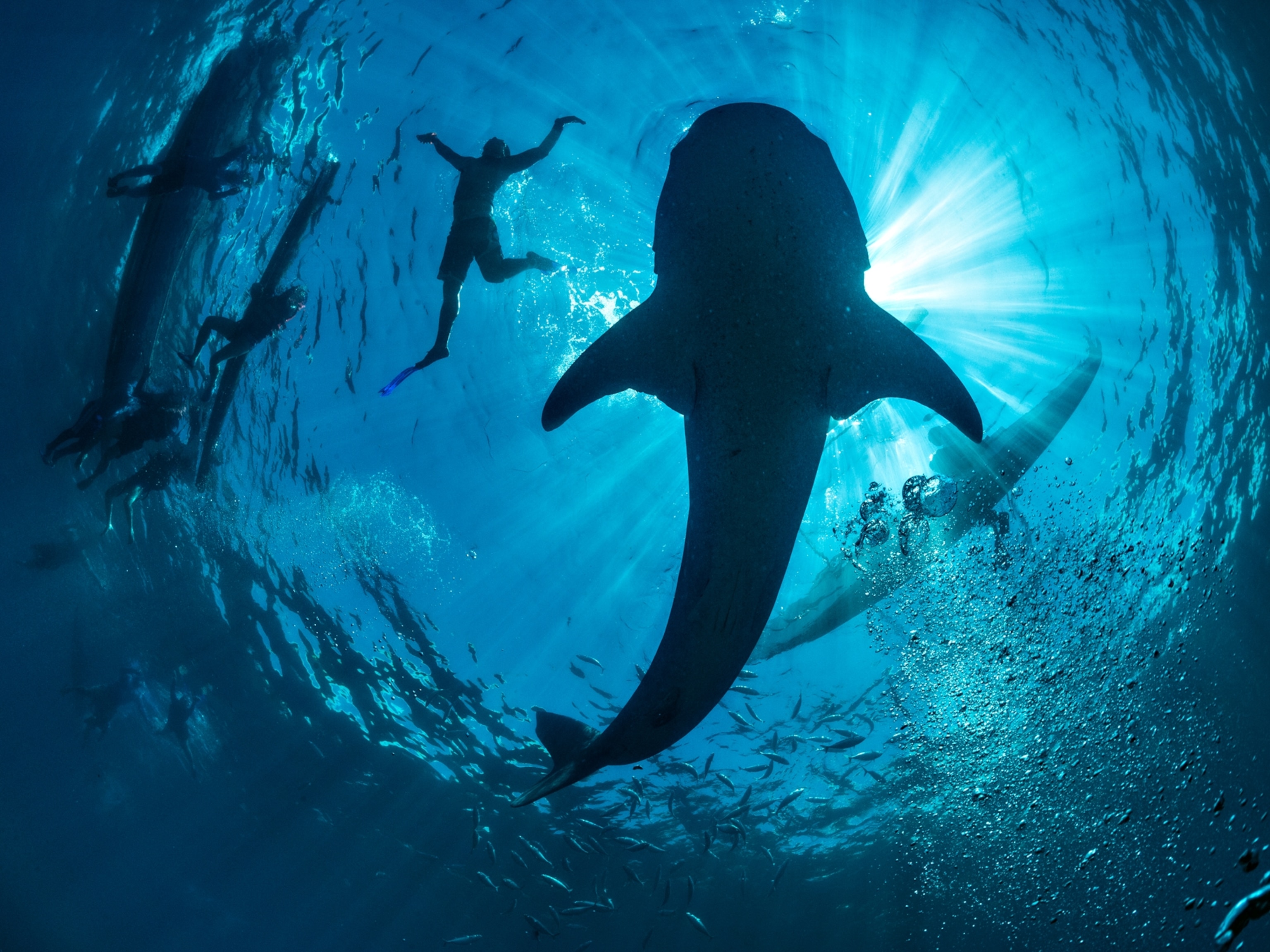This coral reef should be dead—so why is it thriving?
A Honduran coral reef withstood a century of pollution and disease. It could be used to restore dying Caribbean reefs—if scientists can figure out how it survived.

By almost every measure, the coral in Tela Bay should be dead. Yet despite decades of pollution, industrial degradation, and heat waves that have decimated other reefs in the region, this reef on the northern Caribbean coast of Honduras is fantastically, flamboyantly alive.
Tela Bay boasts more than 68 percent live coral cover—a staggering figure compared to the rest of Caribbean, which averages only 18 percent. If scientists can figure out what makes Tela’s reefs so hardy, they could use its secrets—or even just its genes—to repopulate the Caribbean’s withering reefs.
Those efforts are already underway. In May, scientists from the University of Miami collected 13 elkhorn coral specimens from the waters of Tela Bay in the world’s first attempt to breed corals from two different countries to increase their tolerance to the deadly ocean heat waves that are becoming more common with climate change. If the gambit pays off, the new coral could be used to restore the state’s rapidly disappearing reefs.
(Before and after: See what happens to coral reefs in a warming world.)
“If elkhorn is going to survive in Florida, it’s going to need outside help,” says Andrew Baker, a University of Miami marine scientist. “That means we’re going to have to introduce diversity, ideally from a resilient population that’s dealing with the same conditions.”
Baker’s team also collected DNA samples in Honduras, hoping to unravel a mystery researchers have been trying to solve since the tiny Central American inlet showed up on their radar in 2010: Why is the coral reef in Tela Bay so darn tough?
Become a subscriber and support our award-winning editorial features, videos, photography, and more—for as little as $2/mo.
After just weeks in their new Florida tanks, the coral are already starting to give up their secrets.

'Never seen anything like it’
Tela Bay was one of the first places Antal Borcsok ever donned a scuba mask. In 2010, he and his wife, then the owners of a nearby hotel and newly certified divers, decided to while away an afternoon in the tiny inlet.
“There was so much coral—so many varieties, colors, species, growth patterns. It was just beautiful,” says Borcsok, who is now the executive director of Tela Marine, a nonprofit science education program. “But we were new divers, and we thought it must be very normal because no one makes a big deal out of it.”
Still, Borcsok had a hunch they had stumbled upon something special. Soon, he invited friends, more experienced divers from Roatan—the country’s scuba diving mecca—to check it out.
“As soon as we got in the water, they forgot all about us and they started taking pictures,” Borcsok remembers. “They had never seen anything like it.”
Almost no one had ever seen anything like it, in fact.
“Everyone would have assumed that these mainland reefs would be kind of crappy,” says Baker. “There’s a lot of freshwater runoff, a lot of murky water, and huge fluctuations in salinity.”
(7 of the best reef-safe sunscreens.)

In addition to experiencing heat events that would bleach other coral, the species in Tela have been exposed to decades of industrial pollution from the endless shipments of bananas that were once loaded just feet above this delicate ecosystem. They’ve also been subjected to agricultural runoff and spillover from a local wastewater lagoon that serves Tela’s 100,000 residents.
And yet, the coral here thrives. Antlers of critically endangered Elkhorn coral grow in knobby bunches; large fists of brain coral stud the seafloor. How did this happen?
“That's what everyone is trying to find out,” says Borcsok, who, along with his wife, has become “the reef's evangelist.” Together, they have helped make Tela Bay a marine protected area and established the only public aquarium in Central America, inviting Hondurans to discover the dazzling marine life most didn't realize flourishes so close to their shores.
They also put out a call to scientists like Baker to study the coral—and perhaps discover a way to save reefs around the world facing destruction from climate change.
“The Bay is resilient, but everything is resilient only to a certain point; eventually, it will get overwhelmed,” Borcsok says. “So we may not have much time to figure this out.”
Theories of life in Tela Bay
The theories behind Tela’s resilience are almost as varied as the marine life within its waters.
In fact, an undisturbed population of marine critters may be the secret to Tela’s success. While Honduras is home to many fishers, most avoid Tela Bay. Because the maze of coral provides so many hiding places for little fish, big fish tend to stay away—so humans do too. As a result, its waters teem with clams, shrimp, and sea stars that keep harmful algae in check.
Another theory attributes Tela Bay’s vivacity to its unusually high number of long-spined sea urchins—which mysteriously survived a water-borne pathogen in the 1980s that wiped out almost 90 percent of the species elsewhere in the Caribbean. The urchins also graze on algae that can suffocate coral and create spaces for new coral to settle.
(The race to create climate-resilient coral—before it's too late.)
Dan Exton, a coral reef ecologist who has studied Tela, says the urchins have thrived in the bay thanks to its structurally complex coral which provides protection from predators. Still, scientists aren’t sure which one preceded the other. “It’s a real chicken and egg situation,” he says. “What came first, the unusually high population of sea urchins or the exceptionally high abundance of corals?”
For his part, Borcsok has wondered if the fluctuations in salinity have actually protected the bay. Like a swig of mouthwash rinsing away dental plaque, could sporadic rushes of salty water keep pathogens in check? Baker says it’s a reasonable enough theory, though not something that could be investigated scientifically.
One theory Baker could test scientifically is for the presence of heat-resistant symbionts. As their name suggests, symbionts are symbiotic algae that live inside the cells of coral and provide it with energy through photosynthesis. There are many kinds of symbionts, and coral can “shuffle” them around after stressful events, in a process that may help the coral adapt to changing conditions. Could the Honduran reef possess some kind of super-resilient symbiont?
Baker’s work is already beginning to yield some answers. In just a few short weeks, his team has found that Tela’s elkhorn corals “are completely dominated by unusual heat-tolerant symbiont.” The scientist says the symbiont has been identified in individual coral before, but never entire reefs.
While the discovery doesn’t provide a definitive explanation behind Tela Bay’s hardy coral, it’s a hopeful finding, Baker says. “This seems to be a situation in which coral are doing this naturally. [The adaptation] could be a glimpse into the future of coral reefs.”
The future of Tela Bay
There is more good news out of Miami—four of the 13 Honduran elkhorn that the scientists collected have already spawned and been successfully crossed with Florida elkhorn.
“We have several thousand larvae that are in the process of settling into baby coral,” says Baker. “I feel like a new father!”
Still, the scientist is realistic about the work ahead.
“It’s really just the beginning if the reefs in the Caribbean are going to survive,” he says. But Baker hopes this type of genetic exchange between countries will become de rigueur. “Climate change ignores borders,” he says, and so should researchers.
(These images will help you see coral reefs in a whole new way.)
In order for that to happen, Baker argues that regulations around transporting coral across international borders for conservation purposes will need to be streamlined.
“It was a tremendously complicated process of export permits, veterinary clearances, customs inspections. You can just imagine all the questions they had at the airport,” he says.
Back in Tela, Borcsok remains committed to, as he puts it, “uploading Tela’s genes to the cloud,” by creating a back-up coral farm on land. “We could be a genetic seedbank,” says Borcsok. “But our genes need to be exported and taken as many places as possible, until everyone has some of Tela’s genes.”
Related Topics
You May Also Like
Go Further
Animals
- Why manatees often lurk close to Florida's power plantsWhy manatees often lurk close to Florida's power plants
- This Ecuadorian frog was lost for 100 years—until nowThis Ecuadorian frog was lost for 100 years—until now
- We now know why Florida fish spin in circles until they dieWe now know why Florida fish spin in circles until they die
Environment
- This little bird tells the story of the East Coast’s disappearing marshesThis little bird tells the story of the East Coast’s disappearing marshes
- ‘Corn sweat’—and other weird weather phenomena—explained‘Corn sweat’—and other weird weather phenomena—explained
History & Culture
- The 5 scariest mythological witches from around the worldThe 5 scariest mythological witches from around the world
- Meet Emiliano Zapata: hero and martyr of the Mexican RevolutionMeet Emiliano Zapata: hero and martyr of the Mexican Revolution
- Everything you need to know about Hispanic Heritage MonthEverything you need to know about Hispanic Heritage Month
- Your favorite foods have surprising global originsYour favorite foods have surprising global origins
- How did ancient Egyptian obelisks end up all over the world?How did ancient Egyptian obelisks end up all over the world?
Science
- Is America’s legal alcohol limit for driving too high?Is America’s legal alcohol limit for driving too high?
- This Ecuadorian frog was lost for 100 years—until nowThis Ecuadorian frog was lost for 100 years—until now
- How much fiber do you need to reduce your cancer risk?How much fiber do you need to reduce your cancer risk?
- Experts explain what drives hair loss and how to fix itExperts explain what drives hair loss and how to fix it
Tourismus
- Eat like a local in Rome's historic central district
- Paid Content
Eat like a local in Rome's historic central district - Planning a trip to Japan? Here's what you need to knowPlanning a trip to Japan? Here's what you need to know
- 7 alternative experiences in the Indian Ocean
- Paid Content
7 alternative experiences in the Indian Ocean







